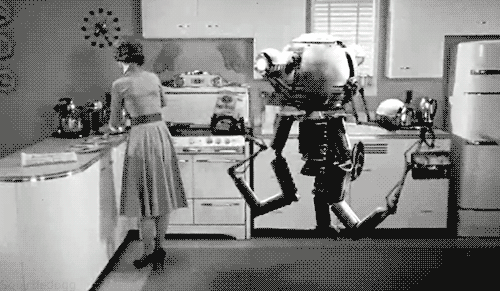Robotics is a subdivision of engineering and computer science, in which robots, or machines capable of carrying out a complex series of actions automatically, are programmed to be capable of performing human-like tasks. Today, the field of robotics seems to be on the rise, however the field did not start to receive recognition until the late 20th Century when great innovations in the world of science were unleashed.
History of Robotics:
The idea of a robot was first displayed in the movie Metropolis in 1927. German actress Brigitte Helm played a robot named Maschinenmensch, also referred to as Maria impersonator.
The next step in the history of robotics was when science fiction writer, Isaac Asimov, created his three laws of robotics. The first of these laws was, "A robot may not injure a human being or, through inaction, allow a human being to come to harm." The next was,"A robot must obey the orders given it by human beings, except where such orders would conflict with the First Law." And finally,"A robot must protect its own existence as long as such protection does not conflict with the First or Second Law." These laws are prominent in Asimov's robotic-based fiction, including his most famous series, Lucky Starr.
In 1984, Norbert Wiener concocted the principles of cybernetics. These principles involve the exploration of different systems, their structure, and the different possibilities and constraints. Concepts explored in cybernetics include; learning, cognition, adaptation, communication, and efficiency. Mr. Wiener defined cybernetics in 1948 as "the scientific study of control and communication in the animal and the machine."
The latest major step in the field of robotics occurred in the late 20th Century, in which fully autonomous robots were first introduced to the world. An autonomous robot is one that performs with a high degree of autonomy, meaning it performs with a certain measure of freedom. The first autonomous robot was Unimate. It was installed in 1961 to remove hot pieces of metal and stack them. Today, robots occupy many jobs that are too dirty or unreliable to have a human perform. Not only are commercial and industrial robots widespread in today's world, but many improvements in A.I. are allowing people to experience everyday lives in a new way. Nowadays, most people own a smartphone, in which a basic A.I., such as Siri, or Cortana, can assist anybody in need of information, with a simple,"Hello Siri," or "Hello google". Vast improvements continue to be made in the field of science, but even more so in the field of robotics. Boston Dynamics has brought robot fiction to life. They created four legged robots that resemble different animals of today's world. For example, they have created a cheetah-like robot called Wildcat, as well as a dog-like robot named BigDog, and finally a humanoid named PetMan. Their most recent innovation is Spot.
Newest Inovation:
Spot is a smaller, quieter, more Eco-friendly version of the series of robots. Spot is approximately the size of a large dog and slimmed down to 160 pounds, not even close to the original series robots. A two-stroke engine powering a hydraulics system, would have made Spot one loud puppy, much like the other robots. However, Boston Dynamics found a way to make Spot much quieter. As opposed to sounding like a chainsaw, like the other models, emitting carbon dioxide, Boston Dynamics switched out the gas engine for an electric engine, making Spot more friendly to the environment, as well as more pleasant to have around. Here's a video of Spot and his owner taking a nice jog around the yard.
Innovations in the field of robotics have come a long way. Robots went from being an invention thought to be thousands of years away, and a century later, here we are. As we began to improve upon the beginning stages, in only 50 years, we went from one industrial robot completing simple tasks such as stacking, to being capable of learning and adapting to situations on their own. For example, they can run on different terrains at high speeds and adapt upon switching terrains. If you try to knock it over, it can regain its balance on its own. These machines can now adapt to changing circumstances, and essentially think for themselves.


No comments:
Post a Comment